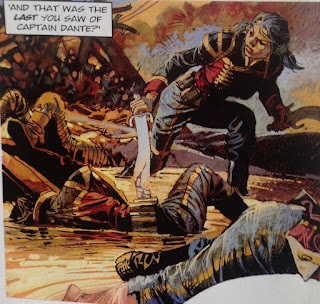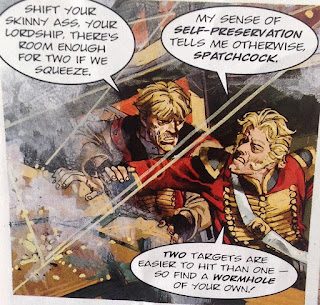First Prog: 738
Latest Prog: 1920
First Meg: 3.40
(aka issue 143)
Latest Meg: 335
Total appearances: 248 and counting
- not including his work on
The Eagle, or indeed his vast output on older British comics, chiefly TV Century 21 and Look-in.
Creator credits:
Black Light, The Bendatti
Vendetta, Angel Zero, The Order
Other art credits:
Judge Dredd
Nikolai Dante
Dr Sin (for his one-off
appearance in the legally dubious 2000 AD Action Special)
Sinister Dexter
Witchworld
A handful of one-offs
 |
| It could be a panel from any given Future Shock. Burns makes it better than that. Words by Brian Williamson (I think) |
Notable character creations:
Emma Paris
The Crystal Skull
Katarina Dante
Marguerite
Spatchcock, Flintlock and
Yelena Kurakin – three of the Rudinshtein Irregulars
PSU judges Jura Edgar and
Roffman*
Notable characteristics:
Classical painted
comics. Scene-setting. A touch of gurning. A hint of retro sci-fi styling. Even
a bit of the Carry-on, although that could be more do to with the inherent tone
of Nikolai Dante than Burns’s art style.
 |
| Burn's Dredd is pure Eastwood. Closed-mouthed at all times! Words by John Wagner |
On John:
John Burns is a
stalwart British comics veteran who came to 2000 AD relatively late on in his
career. I’d be curious to know if he was sought out by then-Tharg, or if he
contacted the offices himself when work for other publishers began to dry up in
the late 1980s. In any event, he was a proper professional with sufficient
talent to only take on work that he wanted. And at first that meant working on Judge Dredd. And not just any old Dredd – mostly the more serious and
indeed wider plot-driven arcs, from the final nail in the coffin of the
Democracy storyline, to the return of Stan Lee, to Raider, one of Garth Ennis’s more moving and less silly pieces, to
the very creation of the Public Surveillance Unit and major Dredd antagonist
Jura Edgar.
 |
| Karl Radier recalls his painful past. Words by Garth Ennis |
 |
| Dredd on bike with motion blur. |
 |
| Edgar on wheelchair with sinister thoughts. Words by John Wagner |
It suits the moodier, character-based stories he was
commissioned to draw. Indeed, he’s one of those artists who makes all his
characters feel lived in and vibrant in a kind of Dickensian way. Not always
subtle, but always potent, and very useful when working on all-new series as
he’s been doing recently.
Outside of a couple of
Vector 13s, and pseudo spin-off Black Light (which I’m still sad never
got beyond it’s original run), Burns remained a Dredd-only artist; indeed as often as not a Wagner-only artist,
until new thrill Nikolai Dante caught
his eye. He soon got himself on the list of rotating artists on that series
until he became the mainstay, taking turns with series co-creator Simon Fraser
up until the end. Personally, my enjoyment of the early episodes of that strip
were a lot to do with Simon Fraser (and I’ll go into that in more detail when
it’s his turn!), but it’s undeniable that Burns helped take the strip in a new
direction, and may indeed have helped inspire Robbie Morrison to try out some different
things, too.
The story goes that
Morrison had originally conceived of Dante
as an alternate history story, rather than full on science fiction. Burns’s
style certainly brings that home. His very first outing on Dante may have centred around futuristic pirate ships, but very
soon he brought his classical touch to scenes of battle that would entirely
suit a history of the Napoleonic Wars.
 |
| Tsar Wars gets off to a sumptuous start. |
Meanwhile, a host of
new fully human characters: Dante’s mother; his cohorts in the Rudinshtein
Irregulars, began to take up more space, leaving less for the more fantastical
aliens and cybernetically enhanced Romanovs.
 |
| Dante and mum |
 |
| The resourceful Sergeant Kurakin |
 |
| The incompetent Spatchcock and Flintlock |
And, where Fraser
brings a sense of anarchy and exaggerated emotion, Burns delivered much more
straight-up comedy and tragedy.
 |
| Comedy |
 |
| Comedy |
 |
| Tragedy All words by Robbie Morrison |
Perhaps simply by virtue of being an artist who
grew up working in a bygone era of British adventure comics, Burns definitely
cemented The Adventures of Nikolai Dante
as a great modern comics epic like they used to make (but maybe never actually
did?**)
Along the way, Burns
teamed up with Robbie Morrison again to dabble in a much more overtly 1970s
style thriller, the Bendatti Vendetta.
This was a brutal revenge strip that combined gangsters with jet-setting and
expensive clothes. And a serious amount of red. Lots of room for Burns to
combine dour faces with grimaces of pain and even cries of anguish. And, unlike
almost any other 2000 AD series, it’s not at all funny.
 |
| Real-world horror Words by Robbie Morrison |
With Dante completed,
Burns was finally free to tackle more Dredd, and, more recently, all-new
stories. Working with veteran one-off wonder Kek-W, Burns leant his classical
stylings to pulpy romp Angel Zero and
phantasmagoric history tale The Order
– a story that I can see returning for a second series one day.
Angel Zero is some respects had a fairly straightforward plot, but my goodness did
the art elevate the material. It’s a classic ‘heroine on a backwater planet
with a happy marriage, who finds that she cannot escape her mysterious and
violent past’. What Burns helped draw out was the emotion of the heroine and
her husband’s plight, and then the impressively weird sci-fi mangling that is
her violent past.
 |
| Angel Zero: girls in jumpsuits fighting Words by Kek-W |
The Order brings in a much larger range of characters: a young woman, a team of
elderly knights, and the evil wirms. I’m especially fond of Ritterstahl, a
robot who has the ghost-like ability to posses the living or even re-animate
dead bodies and is ultimately a crusader knight’s head stuck onto a series of
zombie bodies. One of the latest in a long, long list of supremely original and
weird 2000 AD protagonists, chiefly memorable for his look. And once again,
Burns’ love of period detail (this time, the 13th Century) brings
the story to life in ways that another artist may not have.
 |
| Young knight Anna meets robot knight Ritterstahl Words by Kek-W |
John Burns may not
quite count as the old guard when it comes to 2000AD, but as one of Britihs
comics longest serving artists, he’s a true talent to treasure.
Personal favourites:
The Order
Angel Zero
Judge Dredd: Twilight’s Last Gleaming; The Exterminator***, The Cal Files, Ferals
Nikolai Dante: basically all his episodes are fab, but I do
especially love his gigantic splash page for ‘How could you believe me when I
said I love you when you know I’ve been a liar all my life’? Up there with the
best of Will Eisner, that one.
Sinister Dexter: Witless Protection
 |
| Burns brings the comedy violence, 2000 AD style. Words by Garth Ennis |
More on John Burns
Occasional 2000 AD artist John Haward has a little tribute on his blog.
You may still be able to access an old interview in Dangerous Ink
*I think? Did they
appear before the story ‘The Cal Files’? In any event, Burns’s rendering of
Edgar in particular is pretty definitive.
**My knowledge of
British comics pre-1980 is negligible. I’ve heard of, but never read, the Trigan Empire, which lots of 2000 AD
artists seem to bring up in interviews as inspirational, and sounds a bit
Dante-esque in scope. This may or may not have been the norm!
***Burns only drew the first two episodes of this time travel tale in which Dredd finds himself in late 20th Century New York. Suits his style to a T. It's vastly underrated as a whole, if you ask me. I gather it was reworked by John Wagner from being a Terminator story into a Dredd story. As a result, for the first 6 epsiodes or so, Dredd basically is a villainous Terminator, coming from the future to murder people one by one. Fascinating premise, slightly ruined by the explanation being made obvious too early on.





No comments:
Post a Comment